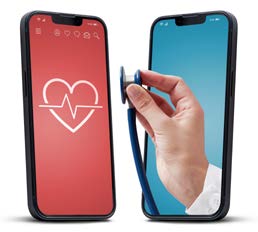Home » Healthcare without borders: the evolving role of telehealth

Pharmacists play an integral role in the broader health network and, as such, it is important to be aware of developments concerning not just the practice of pharmacy but wider healthcare services and offerings available to patients. Emerging trends in the field of health care often intersect with legal developments, and the healthcare industry is traditionally a heavily regulated sector. It will come as no surprise to learn that one of the major evolving areas in the health care industry from a legal perspective is telehealth.
According to the World Health Organisation (WHO), telehealth is the “delivery of healthcare services, where patients and providers are separated by distance. Telehealth uses Information Communication Technology (ICT) for the exchange of information for the diagnosis and treatment of diseases and injuries, research and evaluation, and for the continuing education of health professionals”.
However, it is important to note that there is not a universally agreed definition of telehealth across all jurisdictions, and there are some jurisdictions which do not have specific legislation regarding the provision of telehealth services, leading to an overall lack of regulation in this area. Where regulation exists, it often lags behind the technological developments, which in turn makes it difficult to interpret or apply the legal requirements. Adding to the difficulty is that, in the circumstances of telehealth — and in contrast to traditional healthcare services — there can often be, at a minimum, two different legal jurisdictions at issue: the jurisdiction where the provider is physically located and the jurisdiction where the patient is physically located (in complex cases, even more jurisdictions can be relevant, for example, the jurisdiction/s where the provider is registered/licenced; the jurisdiction of the insurance company or reimbursement entity; the jurisdiction where the prescription, device, or medicinal product is being delivered from, etc.).
Moreover, although the term ‘telehealth’ is often considered synonymous with ‘telemedicine’, some jurisdictions consider the latter to be a much more limited term involving certain clinical care, such as diagnosis and monitoring.
The HSE has recently launched a Telehealth Roadmap 2024-2027, wherein it describes telehealth as the delivery of virtual care for patients in Ireland via remote consultations and care, remote health monitoring, and online supports and therapies. The purpose of the roadmap, according to the HSE, is to provide a strategic plan for telehealth development, and to address challenges and promote adoption of telehealth solutions in healthcare services. It is important for pharmacists to understand how technology is being used to aid in the delivery of care to patients and to explore how to integrate pharmacy into the wider development of telehealth in Ireland.
There are four general categories of telehealth that have traditionally been recognised: real-time, store-and-forward, remote patient monitoring (RPM), and mobile health.
Real-time telehealth
The ‘real-time’ approach is exactly what it sounds like: the delivery of a health consultation, diagnosis, and/or treatment of a patient over a digital platform where the patient and provider can see each other and interact in real-time. This approach is often accepted as falling under the term ‘telemedicine’ and would be the most common approach allowed for reimbursement by health insurance providers or similar entities.
One example from another jurisdiction is the Alabama Department of Public Health Telehealth Programme, which deploys telehealth ‘carts’ across the State. These high-tech carts — containing equipment such as Bluetooth stethoscopes and other peripheral devices — are used by specially trained doctors, nurses and social workers to provide mobile health services to patients, particularly those in rural areas or who otherwise have limited access to hospitals and specialist clinics. The programme works in collaboration with fifteen healthcare agencies to facilitate services such as nephrology, neurology, cardiology, behavioural health, genetic counselling, maternal-foetal medicine, HIV/AIDS, and diabetes education.
Store-and-forward telehealth
Second, the store-and-forward approach utilises electronic communication services to deliver a patient’s medical information to a provider, for example, a specialist consultant, who then evaluates the information and delivers a diagnosis or medical opinion without a ‘live’ encounter with the patient.
Remote Patient Monitoring (RPM)
The RPM approach is similar to the store-and-forward approach in that it involves the collection of patient information electronically and transmits it to a provider at another location. The RPM approach is generally used for the tracking and monitoring of certain information, for example, glucose or blood pressure monitoring, and can be a useful tool for patients with chronic conditions.
For the last few years, different jurisdictions — including the UK, Australia and Canada — have been introducing community-based, pharmacist-delivered medicines management programmes to assist patients with chronic disease. These programmes work to improve chronic disease management and medicines adherence with targeted pharmacist intervention and support. By incorporating RPM technology, such programmes could be particularly effective in optimising patient outcomes and reducing unnecessary hospital admissions.
A more recent example arises from the UK, where the NHS recently announced a framework agreement comprising of NHS organisations and local authorities to procure remote patient monitoring solutions to ease the burden on the health and care system and support the use of ‘virtual wards’. The virtual wards would essentially serve to establish hospital-level care in a home setting (thus decreasing the demand for hospital beds and the number of hospital admissions), by combining technology and remote monitoring and advice, including diagnosis and treatment.
Mobile health
Finally, the mobile health approach is probably the newest category of the four approaches and includes online services and mobile phone apps marketed directly to consumers, often with little or no interaction with a professional health care provider. There is an ever-increasing demand for such services; for example, smart wearable devices, which can track everything from the user’s number of steps each day to their heart rate and blood pressure. This approach represents a surging global market, with no signs of tapering.
Overall, at its best, telehealth contributes to more positive health benefits for patients and consumers by increasing awareness of health conditions, providing resources for early prevention of disease, and allowing ease of access to health information in a way that could have never been envisaged by previous generations. And whilst the number of developments in the field of telehealth are broad and wide-ranging, as with most emerging markets, legislation and regulation generally lag behind the technological developments. It is unsurprising that there may be individuals who wish to take advantage of the lack of regulation in this area. In addition, there are those who would attempt to use telehealth as a means for fraudulent billing, particularly with respect to government reimbursement entities.

For example, in 2021, the U.S. Department of Justice took action against 14 entities, including physicians, healthcare providers, and telehealth executives, alleging fraudulent claims totalling over USD $143 million in false billing. That same year, in a separate U.S. federal case, criminal charges were brought against 138 defendants, spanning across 31 federal districts, for their involvement in alleged healthcare fraud, much of which was perpetrated via telehealth services.
Overall, at its best, telehealth contributes to more positive health benefits for patients and consumers by increasing awareness of health conditions, providing resources for early prevention of disease, and allowing ease of access to health information in a way that could have never been envisaged by previous generations.
There is no doubt that the provision of telehealth services is permitted in Ireland, although it is not defined in Irish legislation. The Irish Medical Council, however, has published guides in relation to this area. In particular, two guides were published in recent years with respect to telemedicine (one for doctors and one for patients), which specifically deal with telephone and video consultations provided by doctors registered in Ireland.
The guides refer to the definition of “telemedicine” as set out in the Medical Council’s Guide to Professional Conduct and Ethics for Registered Medical Practitioners (8th edition 2019), hereafter referred to as the “Ethics Guide”): “Telemedicine describes the delivery of healthcare services through information and communication technologies to promote the health of individuals and their communities. It involves the exchange of information between doctors and patients, or between doctors and professional colleagues, for the diagnosis, treatment and prevention of disease and injuries, and for research, evaluation and continuing education.”
This definition was updated in the 9th Edition (2024) of the Ethics Guide as follows: “Telemedicine is the use of technology such as telephones, websites, apps, and software platforms to provide and support healthcare for patients.” The Ethics Guide further states that if a doctor provides telemedicine services to patients, they “must observe the same standards of conduct and practice as would be expected if treating the patient in-person”.
With respect to the registration of medical practitioners delivering telemedicine services, the Ethics Guide also provides that a doctor who practices telemedicine within Ireland must be registered in the European Union.
It is important to note that the guides published by the Medical Council are not legal requirements, and there can be no doubt that there is a need for more clarity on the legal framework around the provision of telehealth services in Ireland.
The use of digital technology is an ever-increasing aspect of the delivery of healthcare services, but the legal frameworks around it remain uncertain and robust regulatory responses are needed to address the public interest and to deter bad actors who would seek to take advantage of vulnerable patients. Telehealth infrastructures and frameworks should be put into place that are suitable for long-term, widescale use, requiring combined efforts of stakeholders in the health care industry and beyond. A number of initiatives are being developed in Ireland and the European Union in the field of telehealth, and future articles will aim to keep pharmacists informed of these developments.
Although there is currently limited regulation dealing directly with the provision of telehealth services in Ireland, there are a number of emerging trends in technology which pharmacists can and should begin considering for incorporation into their own practices. At DAC Beachcroft, we can help pharmacists navigate through this growing area, to ensure not only maintaining a competitive advantage, but also adherence to relevant legislative and regulatory requirements as they continue to evolve.
About the authors:
Beth Bolger is an Associate in DAC Beachcroft Dublin’s Professional, Public and Regulatory Law team, which is led by Gary Rice, Partner. DAC Beachcroft has advised the IPU and its members for many years and specialises in the legal aspects of pharmacy practice. For more information, please contact Beth Bolger. For more information on any legal aspect of pharmacy practice, please contact Gary Rice.
DAC Beachcroft Dublin

Professional, Public and Regulatory Law Team
Highlighted Articles